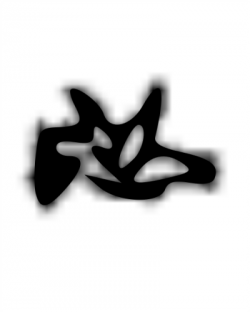Asteroids
This page lists of the various symbols in the Asteroids group.
Asteroids are minor planets (small Solar System bodies and dwarf planets) that are not comets, especially those of the inner Solar System. They have also been called planetoids, especially the larger ones. These terms have historically been applied to any astronomical object orbiting the Sun that did not show the disk of a planet and was not observed to have the characteristics of an active comet, but as small objects in the outer Solar System were discovered, their volatile-based surfaces were found to more closely resemble comets, and so were often distinguished from traditional asteroids. Thus the term asteroid has come increasingly to refer specifically to the small bodies of the inner Solar System out to the orbit of Jupiter. They are grouped with the outer bodies—centaurs, Neptune trojans, and trans-Neptunian objects—as minor planets, which is the term preferred in astronomical circles. In this article the term "asteroid" refers to the minor planets of the inner Solar System.
Symbols in this group:
10 Hygiea
10 Hygiea is the fourth largest asteroid in the Solar System by volume and mass and is located in the asteroid belt.
10 Hygiea
10 Hygiea is the fourth largest asteroid in the Solar System by volume and mass and is located in the asteroid belt.
14 Irene
14 Irene is a large main-belt asteroid, discovered by John Russell Hind on May 19, 1851.
16 Psyche
16 Psyche is one of the ten most massive main-belt asteroids. It is over 200 kilometers in diameter and contains a little less than 1% of the mass of the entire asteroid belt. It is the most massive metallic M-type asteroid.
18 Melpomene
18 Melpomene is a large, bright main-belt asteroid that was discovered by J. R. Hind on June 24, 1852, and named after Melpomenē, the Muse of tragedy in Greek mythology. It is classified as an S-type asteroid and is composed of silicates and metals.
19 Fortuna
19 Fortuna is one of the largest main-belt asteroids. It has a composition similar to 1 Ceres: a darkly colored surface that is heavily space-weathered with the composition of primitive organic compounds, including tholins.
2 Pallas
Pallas, minor-planet designation 2 Pallas, is the second asteroid to have been discovered (after Ceres), and one of the largest in the Solar System
26 Proserpina
26 Proserpina is a main-belt asteroid discovered by R. Luther on May 5, 1853. It is named after the Roman goddess Proserpina, the daughter of Ceres and the Queen of the Underworld.
28 Bellona
28 Bellona is a large main-belt asteroid. It was discovered by R. Luther on March 1, 1854, and named after Bellōna, the Roman goddess of war; the name was chosen to mark the beginning of the Crimean War.
29 Amphitrite
29 Amphitrite is one of the largest S-type asteroids, probably third in diameter after Eunomia and Juno, although Iris and Herculina are similar in size.
3 Juno
Juno, minor-planet designation 3 Juno in the Minor Planet Center catalogue system, was the third asteroid to be discovered and is one of the larger main-belt asteroids, being one of the two largest stony (S-type) asteroids, along with 15 Eunomia.
3 Juno
Juno, minor-planet designation 3 Juno in the Minor Planet Center catalogue system, was the third asteroid to be discovered and is one of the larger main-belt asteroids, being one of the two largest stony (S-type) asteroids, along with 15 Eunomia.
37 Fides
37 Fides (pron.: /ˈfaɪdiːz/ FY-deez) is a large main-belt asteroid. It was discovered by German astronomer Karl Theodor Robert Luther on October 5, 1855, and named after Fides, the Roman goddess of loyalty. Fides was the last of the main-belt asteroids to be assigned an iconic symbol.
4 Vesta
Vesta, minor-planet designation 4 Vesta, is one of the largest asteroids in the Solar System, with a mean diameter of 525 kilometers (326 mi).
4 Vesta
Vesta, minor-planet designation 4 Vesta, is one of the largest asteroids in the Solar System, with a mean diameter of 525 kilometers (326 mi).
4 Vesta
Vesta, minor-planet designation 4 Vesta, is one of the largest asteroids in the Solar System, with a mean diameter of 525 kilometers (326 mi).
5 Astraea
5 Astraea is a large main-belt asteroid. Its surface is highly reflective (bright) and its composition is probably a mixture of nickel-iron with magnesium- and iron-silicates.
5 Astraea
5 Astraea is a large main-belt asteroid. Its surface is highly reflective (bright) and its composition is probably a mixture of nickel-iron with magnesium- and iron-silicates.
6 Hebe
6 Hebe (pron.: /ˈhiːbiː/ HEE-bee) is a large main-belt asteroid, containing around half a percent of the mass of the belt.
6 Hebe
6 Hebe (pron.: /ˈhiːbiː/ HEE-bee) is a large main-belt asteroid, containing around half a percent of the mass of the belt.
7 Iris
7 Iris is a large main-belt asteroid. Among the S-type asteroids, it ranks fifth in geometric mean diameter after Eunomia, Juno, Amphitrite and Herculina.
Cometan Logo
From the age of fifteen, Cometan committed his life to founding a religious and philosophical movement that came to be known as Astronism and that continues to revolutionise the way people around the world view the stars of the night sky. Cometan's cosmic religion has inspired many to see the astronomical world as a source of faith, belief, and meaning for their life. Cometan is currently researching for his PhD in freedom of religion.
Citation
Use the citation below to add this symbols group page to your bibliography:
Style:MLAChicagoAPA
"Asteroids Symbols." Symbols.com. STANDS4 LLC, 2024. Web. 26 Jul 2024. <https://www.symbols.com/group/75/Asteroids>.































Have a discussion about the Asteroids group with the community:
Report Comment
We're doing our best to make sure our content is useful, accurate and safe.
If by any chance you spot an inappropriate comment while navigating through our website please use this form to let us know, and we'll take care of it shortly.
Attachment
You need to be logged in to favorite.
Log In